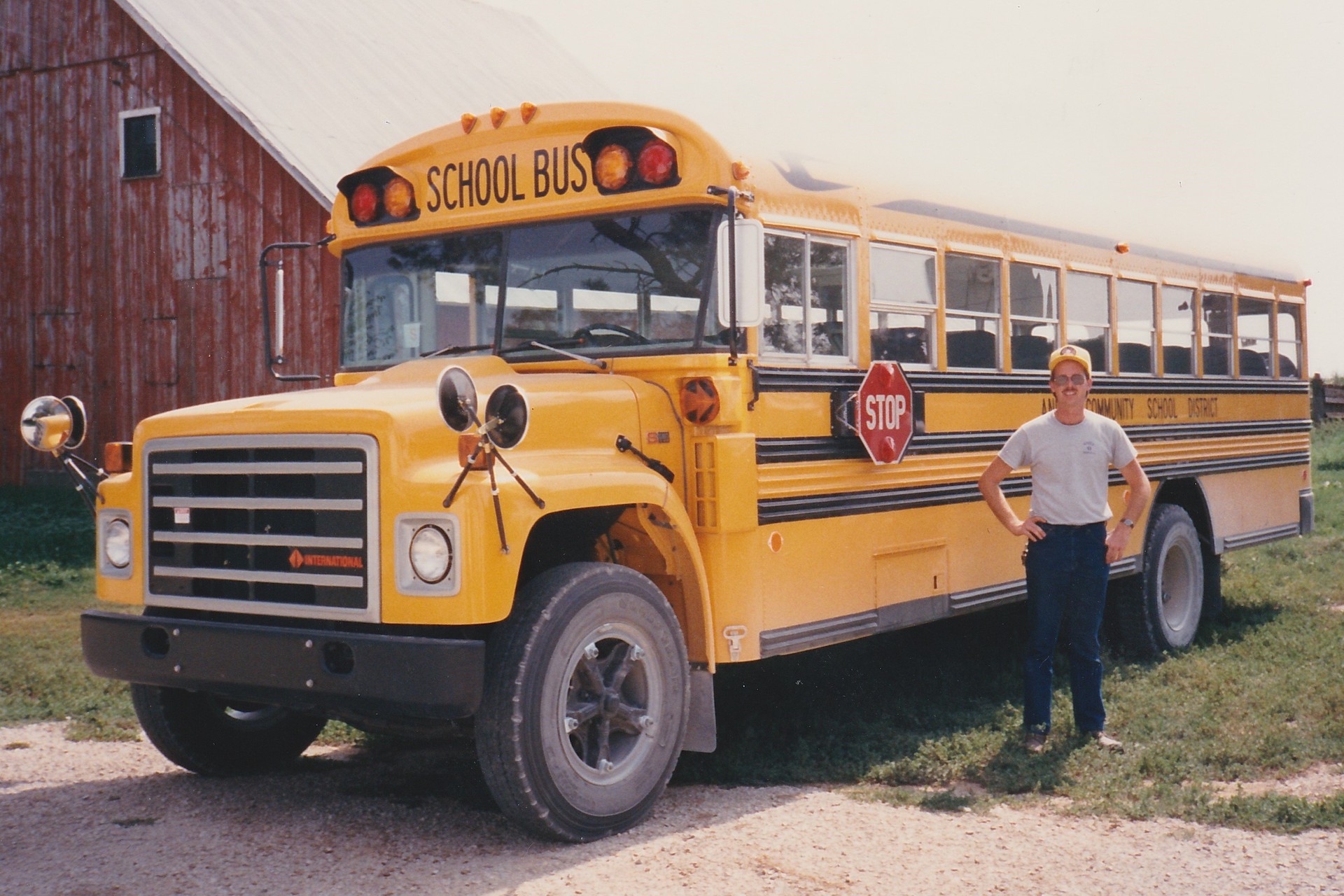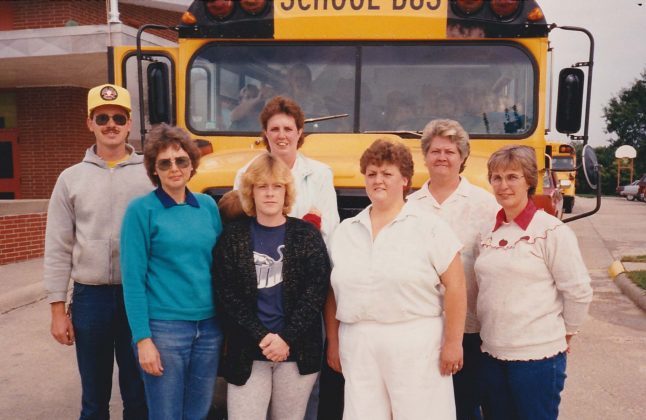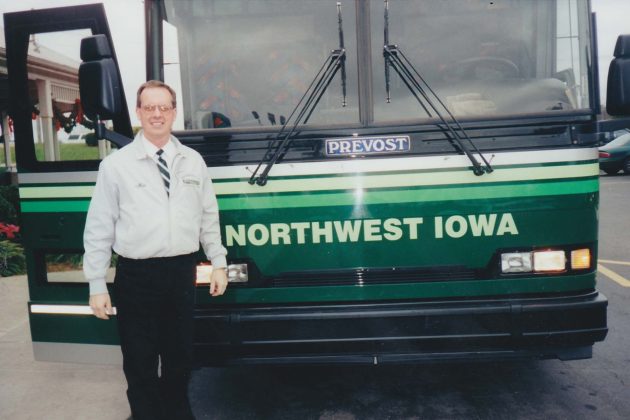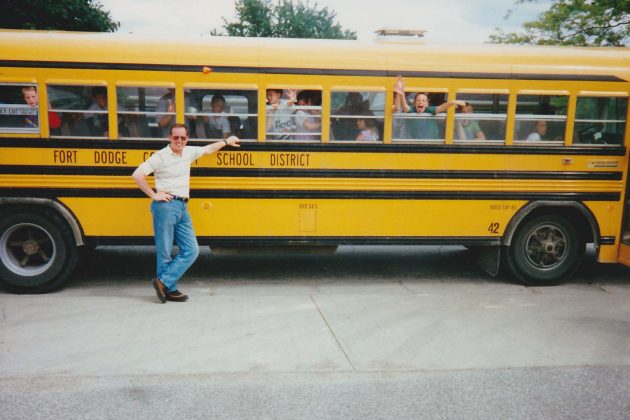Max Christensen has had yellow blood running through his veins since he was born, and while he said he didn’t grow up wanting to be in pupil transportation, he has learned to love the people who make up the industry as well as the children transported safely every day.
Christensen’s school bus story actually started before he was born. His father, Dale Christensen, was a farmer in Iowa but also worked part-time as a school bus driver. He explained that his parents already had a first name picked out for him, but they couldn’t decide on a middle name.
“My dad asked the kids on his bus for suggestions for middle names, and one of the girls on the bus came up with an idea that he liked. He took it to my mom, and she liked it,” Max explained. “So actually, my middle name came from a kid on a school bus. So, it’s kind of like I had yellow blood in my veins pretty much from day one, it feels like.”
Max Corey Christensen would eventually go on to follow in his father’s footsteps and further his career in the pupil transportation industry. While Dale resigned his driver position when Max was about three or four years old, the yellow blood never subsided in the younger Christensen.

In 1986, Christensen was working as a farmer and rented farmland from a man named Roscoe Porch. Meanwhile, Warren Christensen, who was no relation to Max, rented pastureland on the same parcel from Porch. Warren also happened to also be the transportation director at the local Anita Community School District.
Christensen explained that one day, Warren had gotten his pickup truck stuck in a mudhole and he had asked for help to free it. “I drove my tractor down into the pasture and pulled him out of the mudhole,” Christensen recalled. “He reached into his pocket to give me a $20 for my time and effort and I said, ‘No, that’s fine, keep your money. Maybe you can do a good deed for somebody else one day.’”
Little did Max Christensen know that his life would change a year later with Warren’s repayment. Max got a call from the school’s superintendent, who relayed that Warren had moved to Missouri and had recommended Max for the transportation director position. While he was hesitant to take the job, as he hadn’t been on a school bus in over 10 years, Max said he was looking for another job to supplement his farming income.
“There have been a number of times since that I wished I would have just taken the $20,” he laughed. “But as a farmer back in the 1980s, we were just kind of towards the end of the farm crisis, and farmers were looking for a way to make a little extra money because we were pretty much broke out there on the farm. And I thought, ‘Oh, well this will be a good part-time job.’”
The school district position certainly supplemented his farming income, but Christensen soon learned that it was more than a part-time gig. He said he continued to farm for four more years, before joining the district full time.

He worked at Anita for a total of eight years, but his wife Lisa, who he married in 1993, was having a hard time finding a job in that community. However, she found a job as the road representative salesperson for Rieman Music, the largest music company in Iowa, in Fort Dodge, located in central Iowa. So, the young couple moved almost 100 miles north in 1995.
Christensen said it was in Fort Dodge that he worked four different jobs. He was a school bus driver for Fort Dodge Community School District, a motorcoach driver for charter company Northwest Iowa Transportation, a realtor, and a morning show host for radio station KUEL/KVFD. He said he did all that for three years, before taking a position as the transportation director at Perry Community School District in 1998.
He worked at Perry for another five years before applying for and being named the state director for student transportation at the Iowa Department of Education in 2003, where he has been ever since.

The installation of Lap/shoulder Seatbelts
Christensen said that it was at the Iowa Department of Education that he achieved his biggest professional accomplishment, that being the state’s adoption of a lap/shoulder seatbelt requirement, which went into effect last fall. He noted that throughout his 33 years in pupil transportation, the industry has argued about requiring seatbelts in school buses. He said now there is an increased use of the restraint systems nationwide.
“I have younger kids, and right from the get-go they have been in lap/shoulder belts, or seatbelts, literally in everything that they are in,” Christensen explained. “I mean, you go to the grocery store and put them in a shopping cart, there are seatbelts in there. So why don’t we have them in school buses? It just doesn’t make a lot of sense to me. And I just think that is one of the biggest accomplishments our industry has had.”
One reason for the increase in adoption rates could be traced to the position paper published in 2014 by the National Association of Pupil Transportation of State Directors Services (NASDPTS), which called for the installation of lap/shoulder seatbelts in school buses, regardless if there was funding.
Christensen was president of the association at the time. He said that prior to publishing the position paper, NASDPTS was merely supportive of lap/shoulder seatbelts, if there was funding available to school districts. But after watching a school bus crash demonstration at the IMMI/SafeGuard Center for Advanced Product Evaluation facility in Indiana, he said he was no longer on the fence regarding whether seatbelts should be installed in school buses.
“So, in 2014, we wrote a new position paper, stating that we were in favor of lap/shoulder belts,” Christensen explained. “And we took away that funding piece, and at the time we were going out on a limb on our own, because the other associations weren’t too happy with our stance, and a lot of people questioned it. But we also had a lot of people say, ‘It was about time that somebody took a stand on this.’ Without sounding like we are taking too much credit, I think that position paper got the conversation rolling again within the industry, and since then we have seen a lot of states who have now gone to lap/shoulder belts, including Iowa.”

Editor’s Note: NASDPTS published a new paper last month that supersedes the 2014 position. It details how states and individual school districts can best go about introducing the occupant restraint systems on school buses.
“I did save the [positive] emails because sometimes when the going got really tough, I needed to know that I had some support, so I would go back and reread those emails and that kind gave me — it bolstered me back up again,” Christensen added. “And it was a tough struggle.”
In addition to helping write the position paper, he noted that helping to “finally” pass the requirement that requires lap/shoulder seatbelts in school buses in Iowa is one of his top personal accomplishments, which went into effect on Oct. 1, 2019.
Christensen noted there is still a long way to go in requiring lap/shoulder seatbelts in school buses nationwide, but he said he is willing to help any state that seeks guidance.
Related: Iowa Transportation Directors Say Seatbelts are a Step in Right Direction
Related: Iowa Becomes Fifth State to Require Lap/Shoulder Seatbelts In School Buses
Related: NASDPTS Past-President Hollander Retires in Nevada, Profiles Industry Changes
Biggest Operational Change
Christensen said the biggest operational change he has noticed throughout his career has been in school bus driver training and the way school bus drivers run their routes. He said nowadays, drivers have to stick to a customized route and run it very closely. He said if drivers vary from the route at all, it’s going to draw a lot of attention. However, he noted that when he was a driver, he used to mix things up and sometimes drove the route in reverse order on Fridays.
“I mean, the kids weren’t getting home at the same time, and nobody had a real big concern about it,” Christensen said. “But if we were to do that today, everyone would be having a cow. I mean, everybody would be saying, where is the bus at? The parents would be calling the school and a driver like that would probably get fired.”
He noted that driver training has improved for the better, and drivers are given additional information and resources to succeed. Especially in Iowa. When he first started at the Iowa Department of Education, it offered only one annual training session consisting of a 3-hour course that “was okay, but not amazing,” he shared. However, the 12-hour new driving training class offered hadn’t been updated for years and was “pretty antiquated,” he confessed.
One challenge that Christensen discussed was developing a new driver online training course in Iowa, “New Driver STOP Class,” That was put into place in 2010. STOP is an acronym for School Transportation Operators Program. However, he noted it was a five-year process to get the training approved, funded and launched.

He explained that in 2005 he was at an industry conference in Austin, Texas, and a trade show exhibitor demonstrated new online training for school bus drivers. “I looked at that and thought that is exactly what we need,” Christensen recalled.
He said that up until that point, all the training was in-person instructor given and as time went on people got busier and didn’t have time to give up 12 hours for a class, which could have been held over two Saturdays or four Wednesday nights. By putting it online, he noted, the training is now 24/7 and done at the driver’s leisure, as there is no instructor.
Christensen explained that the 14-hour online course is similar to reading a textbook, with the option of having it read to you. He said there are a total of 17 modules with a test at the end of each module and then a final completion test at the end. Driver applicants must pass the final test with a score of 80 percent. The training is provided by School Training Solutions, but Christensen added that it is specific to Iowa and is not a generic course.
“The way we do our training, we do 14-hours online, and we follow it up with three hours of face-to-face training,” Christensen said. “But during that time, [drivers] are taking the training, and we give them a six-month grace period, so they can actually still be driving a school bus, while they are taking the training.”
But he said it wasn’t an easy road to get that training in place.
“We have older school bus drivers, and there was that idea that older school bus drivers aren’t going to want to get on a computer, they don’t know how to get on a computer and this and that,” Christensen explained.
Related: California Approves Virtual Training for School Bus Driver Certifications
Related: Compliance with School Bus Driver Drug, Alcohol Testing Tricky During Closures
Related: School Bus Driver Simulator Provides Real-World Training in Texas
Related: School Training Solutions Adds Five More Counties to Its Online Training Community
However, he said the company trained everyone and now he believes the state is ahead of the game when it comes to utilizing online school bus driver training during the coronavirus pandemic.
“Yeah, some of the drivers are bumping up to their six-month window where they need to get their face-to-face training, but we are simply giving them an extension for when the coronavirus [pandemic] passes,” Christensen said. “So otherwise, I feel good pretty good about it, because our drivers can sit and take the training any time they want, right from their homes.”
Going Forward
Christensen noted that he is at the point where he could retire at any time, but he explained that he is not ready yet, as there are “still things to do.”
He said that it’s all the great people he has met that have kept him in the industry for over 33 years.
“We don’t get into it for the money. We don’t get into it for the glory. Most people, the vast majority of people who are in [the industry], care about kids. We care about the safety of kids,” he concluded.
























